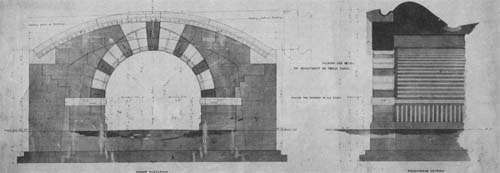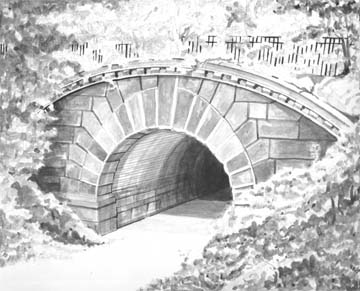Inscope Arch was built in response to a traffic problem. The bottleneck of pedestrians that irritated horseback riders and carriage drivers was enough to convince the Department of Public Parks to seek a remedy in the 1870's. At the time Olmsted, no longer officially connected with Central Park, was a partner in Olmsted and Vaux, Landscape Architects. The firm recommended three new bridges: original Gapstow Bridge, Outset Arch, over the bridle path, and Inscope Arch, the only original one of the three that still remains.
Inscope is well worth a special visit. Beautiful ornamental pink granite surrounds the gray granite that borders the half-oval opening of the archway, 13 feet 7 inches across at the base and 12 feet high in the middle. The archway is Tuscan, that is to say, the top of the voussoirs makes an ogival pattern and the bottom a round one. Encompassing the whole above is a cornice in a segmental arc. Inscope's underpass is 34 feet in length. It has a 100-foot-long railing on top.
It was not easy to construct. Olmsted estimated the cost at $50,000, considerably higher than similar construction during the Civil War days. The site was once a swamp. Although water had been drained off to form the Pond, quicksand lay below. Piles were required, and a subflooring of timber was needed to strengthen the rubble schist foundation. It supported a common-brick barrel vault, originally lined with wood sheathing.
Under the 1973 Central Park Master Plan for restoration of the southeast area of the park, masonry pointing, stone cleaning, painting the brick-vault archway a reflective white, and repair of lights inside the archway were completed. Restoring the wood sheathing to the bricklined walls was deemed too impractical in view of prevalent vandalism.
Inscope Arch is important because it illustrates the continuing creativity of Vaux even after all the designs of the 1850s and 1860s. It is one of those unexpected pleasures discovered when turning a corner in Central Park, nestled unobtrusively in the landscape. Its facings are shielded by embankments, muffling echoes of prevailing urban sound.

Details of granite and brickwork. Original drawing. 1873.
Municipal Archives.



